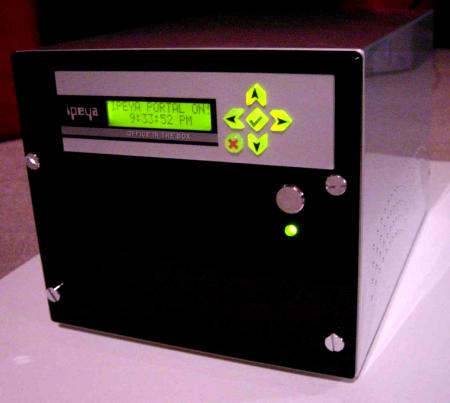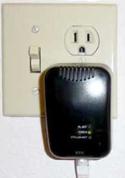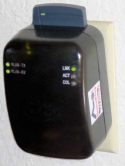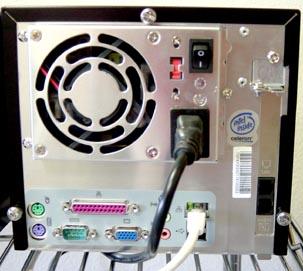Device Profile: Ipeya Small Office IP System
Apr 8, 2004 — by LinuxDevices Staff — from the LinuxDevices Archive — 4 views[Updated May 25, 2004] — The Ipeya Small Office IP System (SIPS) is a Linux-based “office in the box” that integrates a VoIP (voice over IP) telephone/voicemail system with a small office/home office (SOHO) router, firewall, file and print server, and more. It includes IP-telephones and legacy telephone adapters, and supports several types of networking.

SIPS is packaged in a MiniCube box measuring 6.5 x 7.5 x 10.5 inches
(Click to enlarge)
The SIPS uses session initiation protocol (SIP) for compliance and interoperability with a wide range of VoIP PBXs and phones. The device provides a SIP IP PBX with auto attendant. It also provides a gateway between its VoIP network and the public switched telephone network (PSTN), along with voice mail with remote notification.
The SIPS can be used with SIP phones from Ipeya and others, or with normal phones using SIP foreign exchange station (FXS)-VoIP adapters. It supports up to 20 users.
The SIPS includes a WAN router; DHCP server; SIP-aware firewall supporting network address translation (NAT), port filtering, and port forwarding; parallel/USB print server; and, a file server with up to 200GB storage.
CEO Eugene Fleisher says Ipeya is developing additional software add-ons for video surveillance, long distance toll bypass, a distributed IP PBX, email and fax server, click to talk, personal 1-800 number, and more. The add-ons will be free to registered users.
UPDATE: As of May 25, Ipeya has added remote Internet user and branch office capabilities, as shown in the diagram below:

SIPS now supports remote PSTN and VoIP/Internet users
According to Fleisher, SIPS is intended to be easy to install and maintain. It includes network and phone discovery tools, a web-based GUI configurator, and provides a DHCP server and system status display with extensive logging.

 SIPS can be set up with minimal wiring, using standard Ethernet using USB adapters, Home PNA networking (Ethernet over twisted pair telephone lines), or wireless repeaters connected by power circuits using the included Ethernet-powerline adapter (left) and Powerline-wireless adapter (right, click to enlarge).
SIPS can be set up with minimal wiring, using standard Ethernet using USB adapters, Home PNA networking (Ethernet over twisted pair telephone lines), or wireless repeaters connected by power circuits using the included Ethernet-powerline adapter (left) and Powerline-wireless adapter (right, click to enlarge).
What's in the box?
The SIPS is packaged in a MiniCube chassis housing commodity PC hardware. It can be configured with an Intel Celeron processor clocked between 1.7 and 2.4 GHz, and between 128MB and 512MB of RAM. It uses an internal hard drive between 40MB and 250MB. Support for RAID is planned.
The device boots from a write-protected boot image, enabling system recovery in the field, according to Fleisher. “Each system has unique id for security reasons,” he adds.

SIPS includes normal PC back-panel I/O connectors
Interfaces include one foreign exchange office (FXO) PSTN line (“will have four FXO lines soon,” according to Fleisher), one to five Ethernet 10/100 ports, a parallel printer port, and two USB ports.
SIPS provides a web-based interface, as well as a small 16 x 2 LCD display with back light, and six push buttons for menu navigation and system control.
The device also includes amplified internal speakers.
Linux powered
According to Fleisher, the SIPS software is “loosely based” on Linux kernel 2.4.20. “Several system components, including secure file system, support for new devices, etc., have been added, as well as some patches provided by Linux community.”
Fleisher adds that SIPS uses “highly customized” versions of several open source packages.
Ipeya has “extensive expertise in Linux kernel and application development,” according to Fleisher, and the company did all its own Linux porting, support, and customizations in-house.
Why Linux
Fleisher calls Linux “The only reliable and price-wise acceptable OS on the market for our application.” He continues, “There is collection of reliable server applications which can be used to build our product. Linux provides an extensive coverage for the system parts and allows building the prototype and a product fast with less investment up front.”
Linux is not without imperfections, though, according to Fleisher, who says there are “Too many similar implementations of the same parts,” making it difficult at times to choose the right one “until you dive deep into it.”
Additionally, Fleisher notes that some newer hardware components are not supported, or software for them has not undergone enough testing. “One of the challenges with open source software is to correctly assess its level of readiness,” he says. Another challenge is the “time required to take [open source applications] to production state.”
Despite challenges, Fleisher believes that Linux has a great future, especially in the embedded market. “There is tremendous advantage of having the source code and many groups of people improving it every day. Even today, a lot of telecom systems are already using this very powerful platform. Add-on web based software applications will successfully counter-play the Windows camp.”
Fleisher concludes, “Choosing Linux had been the right decision for us, and we are planning to continue using it in the future for next generation products.”
Availability
The Ipeya SIPS costs $1,499 with a single FXO line (VOIP-PSTN gateway) and five user licenses. It costs $2,499 with an embedded five-port hub and a 20-user license. Both configurations include Ethernet-to-powerline and Powerline-to-wireless adapters, for phone placement near any power outlet. Up to three $499 external four-port FXO modules can be added.
This article was originally published on LinuxDevices.com and has been donated to the open source community by QuinStreet Inc. Please visit LinuxToday.com for up-to-date news and articles about Linux and open source.